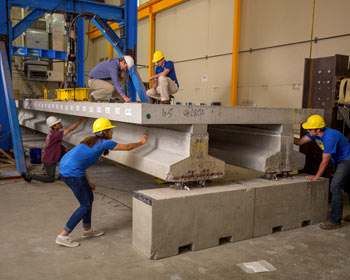MPC Research Reports
Report Details
Abstract
 The South Dakota Department of Transportation (SDDOT) allows the use of precast double-tee bridges in counties because they are economical and fast in construction. Alternative durable prefabricated bridge systems are needed to provide more options to local governments. The present study was carried out to investigate the feasibility of alternative prefabricated bridge systems that can be incorporated in South Dakota. The project technical panel approved testing of two superstructure bridge systems: (1) precast full-depth deck panels on prestressed inverted tee girders and (2) glulam timber bridges. The present report includes the design, construction, testing methods, and recommendations for the selected bridge alternatives. Three full-scale bridges, one fully precast and two glulam timber, were tested under fatigue and ultimate loading. The precast bridge specimen was 50-ft long by 9.5-ft wide. No significant damage beyond the prior-to-testing shrinkage cracks was observed throughout the entire fatigue test, and the overall bridge stiffness did not deteriorate. The strength load testing showed that the load amplitude at the first crack was higher than the AASHTO Service and Strength I limit state loads, indicating sufficient performance. Based on the construction, testing, and cost analysis, it was concluded that the precast full-depth deck panels on prestressed inverted tee girder bridge is a viable alternative to the double-tee girder bridge. The full-scale glulam girder bridge test model was 50-ft long and 9.25-ft wide. The full-scale glulam slab bridge was 16.5-ft long and 8-ft wide. Both timber bridge types showed minimal damage during fatigue testing. The only damage to the girder timber bridge was cracking of tongue-and-groove deck-to-deck connections, which can be eliminated using flat-end panels. Ultimate testing of the two bridge systems confirmed that the AASHTO design method for timber bridges is adequate. Girders of glulam bridges should be designed as fully non-composite members. Based on the construction, testing, and cost analysis, it was concluded that both types of glulam timber bridges are viable alternatives to the double-tee girder bridges.
The South Dakota Department of Transportation (SDDOT) allows the use of precast double-tee bridges in counties because they are economical and fast in construction. Alternative durable prefabricated bridge systems are needed to provide more options to local governments. The present study was carried out to investigate the feasibility of alternative prefabricated bridge systems that can be incorporated in South Dakota. The project technical panel approved testing of two superstructure bridge systems: (1) precast full-depth deck panels on prestressed inverted tee girders and (2) glulam timber bridges. The present report includes the design, construction, testing methods, and recommendations for the selected bridge alternatives. Three full-scale bridges, one fully precast and two glulam timber, were tested under fatigue and ultimate loading. The precast bridge specimen was 50-ft long by 9.5-ft wide. No significant damage beyond the prior-to-testing shrinkage cracks was observed throughout the entire fatigue test, and the overall bridge stiffness did not deteriorate. The strength load testing showed that the load amplitude at the first crack was higher than the AASHTO Service and Strength I limit state loads, indicating sufficient performance. Based on the construction, testing, and cost analysis, it was concluded that the precast full-depth deck panels on prestressed inverted tee girder bridge is a viable alternative to the double-tee girder bridge. The full-scale glulam girder bridge test model was 50-ft long and 9.25-ft wide. The full-scale glulam slab bridge was 16.5-ft long and 8-ft wide. Both timber bridge types showed minimal damage during fatigue testing. The only damage to the girder timber bridge was cracking of tongue-and-groove deck-to-deck connections, which can be eliminated using flat-end panels. Ultimate testing of the two bridge systems confirmed that the AASHTO design method for timber bridges is adequate. Girders of glulam bridges should be designed as fully non-composite members. Based on the construction, testing, and cost analysis, it was concluded that both types of glulam timber bridges are viable alternatives to the double-tee girder bridges.
How to Cite
Carnahan, Zachary, Michael Mingo, Mostafa Tazarv, and Nadim Wehbe. Development of Alternative Bridge Superstructures for South Dakota Local Roads, MPC-19-373. North Dakota State University - Upper Great Plains Transportation Institute, Fargo: Mountain-Plains Consortium, 2019.

